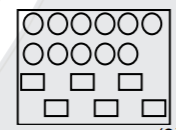Unit of equilibrium constant is:
(molL−1)1−n
(molL−1)Δn
(atm)Δn
All
The correct Answer is:B, C
To determine the unit of the equilibrium constant, we need to understand the definitions of Kc and Kp and how to calculate them based on the stoichiometry of a given chemical reaction.
1. Understand the Equilibrium Constant:
- The equilibrium constant Kc is used for reactions in terms of concentration (molarity), while Kp is used for reactions in terms of partial pressures.
2. Define Kc:
- For a general reaction:
aA+bB⇌cC+dD
- The expression for Kc is given by:
Kc=(C)c(D)d(A)a(B)b
- Here, (A), (B), (C), and (D) are the molar concentrations of the reactants and products.
3. Calculate the Change in Moles (Δn):
- Δn is defined as:
Δn=(c+d)−(a+b)
- This represents the change in the number of moles of gaseous products minus the number of moles of gaseous reactants.
4. Determine the Units of Kc:
- The units of Kc can be derived from the expression:
Kc=(products)(reactants)
- The units of concentration are moles per liter (mol/L). Therefore, the units of Kc can be expressed as:
Kc units=(mol/L)Δn=molΔn⋅L−Δn
- This can also be written as:
mol⋅L−1 wholeΔn
5. Define Kp:
- For the same reaction, the expression for Kp is given by:
Kp=(PC)c(PD)d(PA)a(PB)b
- Here, P represents the partial pressures of the gases involved in the reaction.
6. Determine the Units of Kp:
- The units of pressure are typically in atmospheres (atm). Therefore, the units of Kp can be expressed as:
Kp units=atmΔn
Summary of Units:
- The unit of Kc is molΔn⋅L−Δn or mol⋅L−1 wholeΔn.
- The unit of Kp is atmΔn.
- The equilibrium constant Kc is used for reactions in terms of concentration (molarity), while Kp is used for reactions in terms of partial pressures.
- For a general reaction:
aA+bB⇌cC+dD
- The expression for Kc is given by:
Kc=(C)c(D)d(A)a(B)b
- Here, (A), (B), (C), and (D) are the molar concentrations of the reactants and products.
- Δn is defined as:
Δn=(c+d)−(a+b)
- This represents the change in the number of moles of gaseous products minus the number of moles of gaseous reactants.
- The units of Kc can be derived from the expression:
Kc=(products)(reactants)
- The units of concentration are moles per liter (mol/L). Therefore, the units of Kc can be expressed as:
Kc units=(mol/L)Δn=molΔn⋅L−Δn
- This can also be written as:
mol⋅L−1 wholeΔn
- For the same reaction, the expression for Kp is given by:
Kp=(PC)c(PD)d(PA)a(PB)b
- Here, P represents the partial pressures of the gases involved in the reaction.
- The units of pressure are typically in atmospheres (atm). Therefore, the units of Kp can be expressed as:
Kp units=atmΔn
- The unit of Kc is molΔn⋅L−Δn or mol⋅L−1 wholeΔn.
- The unit of Kp is atmΔn.
Topper's Solved these Questions
- CHEMICAL EQUILIBRIUMBOOK - CENGAGE CHEMISTRY ENGLISHCHAPTER - CHEMICAL EQUILIBRIUMEXERCISE - Exercises (Single Correct)
58 Videos
- CHEMICAL EQUILIBRIUMBOOK - CENGAGE CHEMISTRY ENGLISHCHAPTER - CHEMICAL EQUILIBRIUMEXERCISE - Exercises (Assertion-Reasoning)
15 Videos
- CHEMICAL EQUILIBRIUMBOOK - CENGAGE CHEMISTRY ENGLISHCHAPTER - CHEMICAL EQUILIBRIUMEXERCISE - Exercises (Linked Comprehensive)
54 Videos
- CHEMICAL BONDING AND MOLECULAR STRUCTUREBOOK - CENGAGE CHEMISTRY ENGLISHCHAPTER - CHEMICAL BONDING AND MOLECULAR STRUCTUREEXERCISE - Archives Subjective
15 Videos
- CLASSIFICATION AND NOMENCLATURE OF ORGANIC COMPOUNDSBOOK - CENGAGE CHEMISTRY ENGLISHCHAPTER - CLASSIFICATION AND NOMENCLATURE OF ORGANIC COMPOUNDSEXERCISE - Analytical and Descriptive Type
3 Videos
Similar Questions
Unit of equilibrium constant Kp for the reaction PCl5(g)⇔PCl3(g)+Cl2(g) is
View SolutionUnit of equilibrium constant (Kc) for the reaction N2(g)+3H2(g)<⇒2NH3(g), will be
View SolutionThe unit of equilibrium constant Kc for the reaction A+B⇔C would be
View SolutionThe unit of equilibrium constant KC of a reaction is mol−2l2.For this reaction, the product concentration increases by
View SolutionConsider the imaginary equilibrium 4A(g)+5B(g)⇔4X(g)+6Y(g), The unit of equilibrium constant KC is
View SolutionWrite the unit of equilibrium constant (Kc) for the given reaction.
BaCO3(s)⇔BaO(s)+CO2(g)
View SolutionKp and Kc are inter related as
Kp=Kc(RT)Δn
Answer the following questions:
The unit of equilibrium constant for
H2(g)+I2(g)⇔2HI(g)
View SolutionWhich statement for equilibrium constant is true for the reaction A+B⇔C?
View SolutionAt equilibrium, the value of equilibrium constant K is
View SolutionReactant A represented by square is in equilibrium with product B represented by circles. Then value of equilibrium constant is

View Solution
